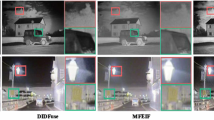Abstract
Distortion-free enhancement on images captured under low-light conditions has always been a challenging problem in computer vision. Although many image enhancement methods have been proposed, most existing algorithms cause artifacts and amplify the noise in the enhanced image, which greatly affect the visual perception of the enhanced image. To address these problems, this paper proposes an unsupervised learning based dual-branch fusion low-light image enhancement algorithm, which can learn the map way of low-light images to normal-light images from unpaired low-light and normal-light datasets. The network is consisted of dual branches, the upper branch is a refinement branch focusing on noise suppression, and the lower branch is a U-Net-like global reconstruction branch based on the attention mechanism for high-quality image generation. The discrimination network adopts the multi-scale discrimination structure of feature pyramid to enhance the global consistency and avoid local overexposure. The loss function is also improved, and a new fidelity cycle consistency loss is introduced to further improve the quality of image texture information recovery. Qualitative and quantitative experimental results show that the proposed method can effectively suppress the generation of artifacts and noise amplification of enhanced images.










Similar content being viewed by others
Data Availability
All data generated during this study are included in these published articles:
1) LOL https://doi.org/10.48550/arXiv.1808.04560
2) Brightening https://dl.acm.org/doi/abs/10.1145/2713168.2713194
3) MEF https://ieeexplore.ieee.org/document/7120119/keywords#keywords
4) LIME https://pubmed.ncbi.nlm.nih.gov/28113318/
References
Abdullah-Al-Wadud M, Kabir MH, Dewan MAA, Chae O (2007) A dynamic histogram equalization for image contrast enhancement. IEEE Trans Consum Electron 53(2):593–600
Bochkovskiy A, Wang C-Y, Liao H-YM (2020) Yolov4: Optimal speed and accuracy of object detection. arXiv:2004.10934
Chaudhary S, Bhardwaj A, Rana P (2022) Image enhancement by linear regression algorithm and sub-histogram equalization. Multimedia Tools Appl
Chen C, Chen Q, Xu J, Koltun V (2018) Learning to see in the dark. In: Proceedings of the IEEE conference on computer vision and pattern recognition, pp 3291–3300
Chen X, Li J, Hua Z (2022) Retinex low-light image enhancement network based on attention mechanism. Multimedia Tools Appl
Dang-Nguyen D. -T., Pasquini C, Conotter V, Boato G (2015) Raise: a raw images dataset for digital image forensics. In: Proceedings of the 6th ACM multimedia systems conference, pp 219–224
Drago F, Myszkowski K, Annen T, Chiba N, Fellner DW (2003) Adaptive logarithmic mapping for displaying high contrast scenes. In: Computer graphics forum
Engin D, Genç A, Kemal Ekenel H (2018) Cycle-dehaze: enhanced cyclegan for single image dehazing. In: Proceedings of the IEEE conference on computer vision and pattern recognition workshops, pp 825–833
Fang Y, Zhang C, Yang W, Liu J, Guo Z (2018) Blind visual quality assessment for image super-resolution by convolutional neural network. Multimed Tools Appl 77(22):29829–29846
Fang Y, Zhu H, Zeng Y, Ma K, Wang Z (2020) Perceptual quality assessment of smartphone photography. In: 2020 IEEE/CVF conference on computer vision and pattern recognition (CVPR)
Goodfellow I, Pouget-Abadie J, Mirza M, Xu B, Warde-Farley D, Ozair S, Courville A, Bengio Y (2014) Generative adversarial nets. Adv Neural Inf Process Syst:27
Guo C, Li C, Guo J, Loy CC, Hou J, Kwong S, Cong R (2020) Zero-reference deep curve estimation for low-light image enhancement. In: Proceedings of the IEEE/CVF Conference on Computer Vision and Pattern Recognition, pp 1780–1789
Guo X, Li Y, Ling H (2016) Lime: Low-light image enhancement via illumination map estimation. IEEE Trans Image Process 26(2):982–993
Hao S, Zhuang F, Guo Y (2018) Low-light image enhancement with a refined illumination map. Multimed Tools Appl 77(22):29639–29650
Hu J, Shen L, Sun G (2018) Squeeze-and-excitation networks. In: Proceedings of the IEEE Conference on Computer Vision and Pattern Recognition, pp 7132–7141
Isola P, Zhu J. -Y., Zhou T, Efros AA (2017) Image-to-image translation with conditional adversarial networks. In: Proceedings of the IEEE conference on computer vision and pattern recognition, pp 1125–1134
Jebadass JR, Balasubramaniam P (2022) Low light enhancement algorithm for color images using intuitionistic fuzzy sets with histogram equalization. Multimed Tools Appl 81(6):8093–8106
Jiang Y, Gong X, Liu D, Cheng Y, Fang C, Shen X, Yang J, Zhou P, Wang Z (2021) Enlightengan: deep light enhancement without paired supervision. IEEE Trans Image Process 30:2340–2349
Jin S, Qi N, Zhu Q, Ouyang H (2022) Progressive gan-based transfer network for low-light image enhancement. In: International conference on multimedia modeling, pp 292–304
Kim TH, Lee KM, Schölkopf B., Hirsch M (2017) Online video deblurring via dynamic temporal blending network. In: 2017 IEEE international conference on computer vision (ICCV), pp 4058–4067
Kimmel R, Elad M, Shaked D, Keshet R, Sobel I (2003) A variational framework for retinex. Int J Comput Vision 52(1):7–23
Kingma DP, Ba J (2014) Adam: A method for stochastic optimization. arXiv:1412.6980
Land EH (1977) The retinex theory of color vision. Scientific american 237(6):108–129
Lee C, Lee C, Kim C-S (2013) Contrast enhancement based on layered difference representation of 2d histograms. IEEE Trans Image Process 22 (12):5372–5384
Li C, Guo C, Chen CL (2021) Learning to enhance low-light image via zero-reference deep curve estimation. IEEE Trans Software Eng
Li C, Guo C, Chen CL (2021) Learning to enhance low-light image via zero-reference deep curve estimation. IEEE Trans Patt Anal Mach Intell
Li C, Guo J, Porikli F, Pang Y (2018) Lightennet: a convolutional neural network for weakly illuminated image enhancement. Pattern Recognit Lett 104:15–22
Lin T-Y, Dollár P, Girshick R, He K, Hariharan B, Belongie S (2017) Feature pyramid networks for object detection. In: Proceedings of the IEEE conference on computer vision and pattern recognition, pp 2117–2125
Liu RW, Guo Y, Lu Y, Chui KT, Gupta BB (2022) Deep network-enabled haze visibility enhancement for visual iot-driven intelligent transportation systems. IEEE Trans Industr Inf:1–1
Liu X, Ma W, Ma X, Wang J (2022) Lae-net: A locally-adaptive embedding network for low-light image enhancement. Pattern Recognit:109039
Liu R, Ma L, Zhang J, Fan X, Luo Z (2021) Retinex-inspired unrolling with cooperative prior architecture search for low-light image enhancement. In: Computer vision and pattern recognition
Loh YP, Chan CS (2019) Getting to know low-light images with the exclusively dark dataset. Comput Vis Image Underst 178:30–42
Long J, Shelhamer E, Darrell T (2015) Fully convolutional networks for semantic segmentation. In: Proceedings of the IEEE Conference on Computer Vision and Pattern Recognition, pp 3431–3440
Lore KG, Akintayo A, Sarkar S (2017) Llnet: a deep autoencoder approach to natural low-light image enhancement. Pattern Recogn 61:650–662
Lv F, Lu F, Wu J, Lim C (2018) Mbllen: low-light image/video enhancement using cnns. In: BMVC, vol 220, p 4
Ma K, Zeng K, Wang Z (2015) Perceptual quality assessment for multi-exposure image fusion. IEEE Trans Image Process 24(11):3345–3356
Meng Y, Kong D, Zhu Z, Zhao Y (2019) From night to day: gans based low quality image enhancement. Neural Process Lett 50(1):799–814
Meylan L, Susstrunk S (2006) High dynamic range image rendering with a retinex-based adaptive filter. IEEE Trans Image Process 15(9):2820–2830
Mirza M, Osindero S (2014) Conditional generative adversarial nets. Comput Sci:2672–2680
Ni Z, Yang W, Wang S, Ma L, Kwong S (2020) Towards unsupervised deep image enhancement with generative adversarial network. IEEE Trans Image Process 29:9140–9151
Pizer SM, Amburn EP, Austin JD, Cromartie R, Geselowitz A, Greer T, ter Haar Romeny B, Zimmerman JB, Zuiderveld K (1987) Adaptive histogram equalization and its variations. Comput Vision, Graph, Image Process 39 (3):355–368
Rongkai Z, Lanqing G, Siyu H, Bihan W (2021) Rellie: Deep reinforcement learning for customized low-light image enhancement. In: Inproceedings of the 29th ACM international conference on multimedia, pp 2429–2437
Ronneberger O, Fischer P, Brox T (2015) U-net: Convolutional networks for biomedical image segmentation. In: International conference on medical image computing and computer-assisted intervention, pp 234–241
Simonyan K, Zisserman A (2014) Very deep convolutional networks for large-scale image recognition. Comput Sci
Sun X, Li M, He T, Fan L (2021) Enhance images as you like with unpaired learning. CoRR
Thomas G, Flores-Tapia D, Pistorius S (2011) Histogram specification: a fast and flexible method to process digital images. IEEE Trans Instrum Meas 60(5):1565–1578
Wang P, Wang Z, Lv D, Zhang C, Wang Y (2021) Low illumination color image enhancement based on gabor filtering and retinex theory. Multimed Tools Appl:1–15
Wang S, Zheng J, Hu H-M, Li B (2013) Naturalness preserved enhancement algorithm for non-uniform illumination images. IEEE Trans Image Process 22(9):3538–3548
Wei C, Wang W, Yang W, Liu J (2018) Deep retinex decomposition for low-light enhancement. arXiv:1808.04560
Yan L, Fu J, Wang C, Ye Z, Chen H, Ling H (2021) Enhanced network optimized generative adversarial network for image enhancement. Multimed Tools Appl:1–19
Yang W, Wang S, Fang Y, Wang Y, Liu J (2020) From fidelity to perceptual quality: a semi-supervised approach for low-light image enhancement. In: Proceedings of the IEEE/CVF conference on computer vision and pattern recognition, pp 3063–3072
Zhang R, Isola P, Efros AA, Shechtman E, Wang O (2018) The unreasonable effectiveness of deep features as a perceptual metric. IEEE/CVF Conf Comput Vision Patt Recognit
Zhao M, Zhong S, Fu X, Tang B, Pecht M (2020) Deep residual shrinkage networks for fault diagnosis. IEEE Trans Indust Inf
Zheng C, Shi D, Shi W (2021) Adaptive unfolding total variation network for low-light image enhancement. In: Proceedings of the IEEE/CVF international conference on computer vision, pp 4439–4448
Zhi N, Mao S, Li M (2018) An enhancement algorithm for coal mine low illumination images based on bi-gamma function. Liaoning Gongcheng Jishu Daxue Xuebao (Ziran Kexue Ban)/J Liaoning Techn Univ (Natural Sci Edition) 37(1):191–197
Zhu M, Pan P, Chen W, Yang Y (2020) Eemefn: low-light image enhancement via edge-enhanced multi-exposure fusion network. Proc AAAI Conf Artif Intell 34(7):13106–13113
Zhu J. -Y., Park T, Isola P, Efros AA (2017) Unpaired image-to-image translation using cycle-consistent adversarial networks. In: Proceedings of the IEEE international conference on computer vision, pp 2223–2232
Acknowledgements
This work was supported by the Natural Science Foundation of China NSFC under Grants 61871445, 61302156; Key R & D Foundation Project of Jiangsu province under Grant BE2016001-4.
Author information
Authors and Affiliations
Corresponding author
Ethics declarations
Conflict of Interests
We declare that we have no financial and personal relationships with other people or organizations that can inappropriately influence our work, there is no professional or other personal interest of any nature or kind in any product, service and/or company that could be construed as influencing the position presented in, or the review of, the manuscript entitled, “Unsupervised Learning based Dual-branch Fusion Low-light Image Enhancement”.
Additional information
Publisher’s note
Springer Nature remains neutral with regard to jurisdictional claims in published maps and institutional affiliations.
Yu Zhou contributed equally to this work.
Rights and permissions
Springer Nature or its licensor (e.g. a society or other partner) holds exclusive rights to this article under a publishing agreement with the author(s) or other rightsholder(s); author self-archiving of the accepted manuscript version of this article is solely governed by the terms of such publishing agreement and applicable law.
About this article
Cite this article
Han, G., Zhou, Y. & Zeng, F. Unsupervised learning based dual-branch fusion low-light image enhancement. Multimed Tools Appl 82, 37593–37614 (2023). https://doi.org/10.1007/s11042-023-15147-w
Received:
Revised:
Accepted:
Published:
Issue Date:
DOI: https://doi.org/10.1007/s11042-023-15147-w




